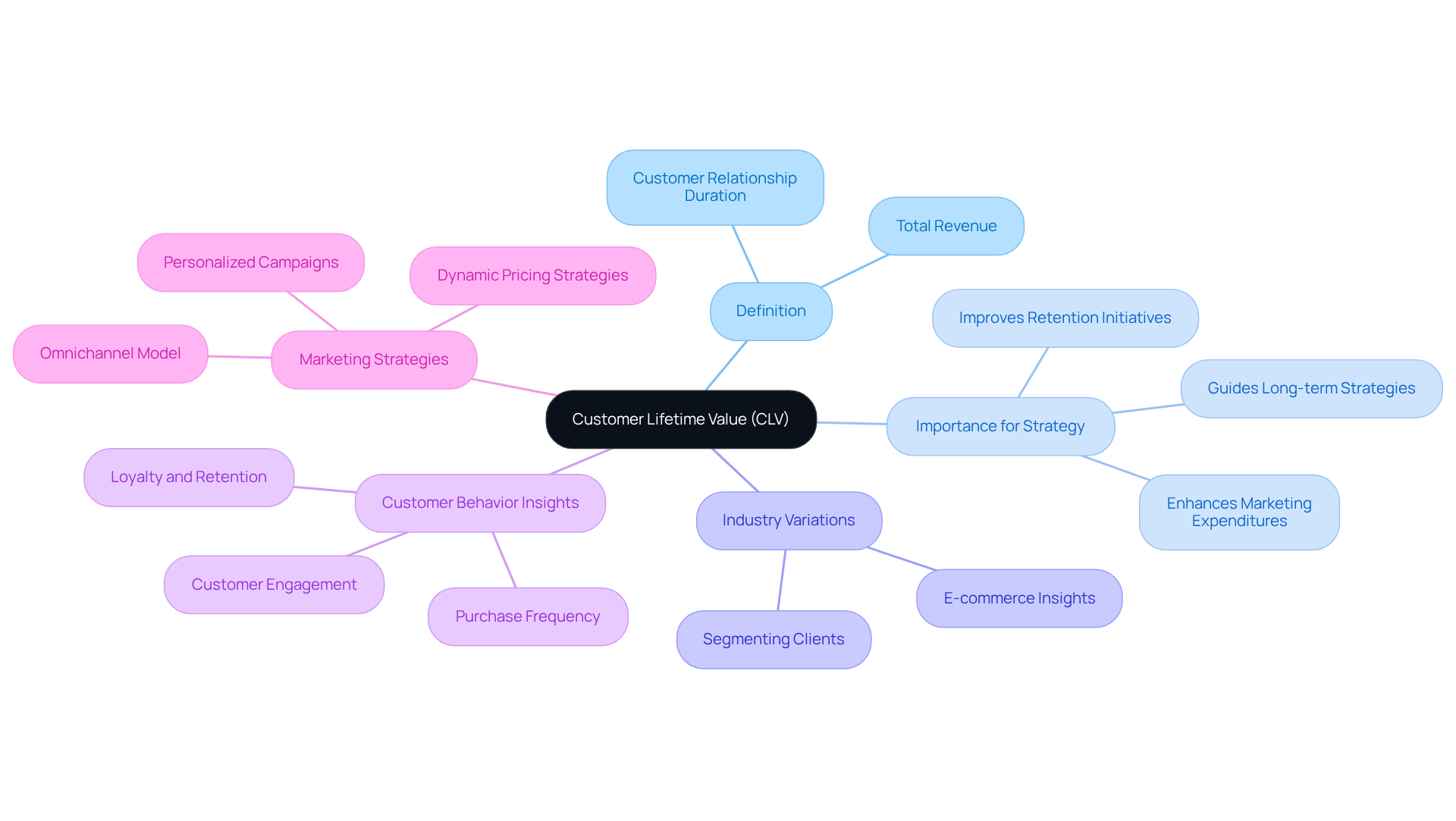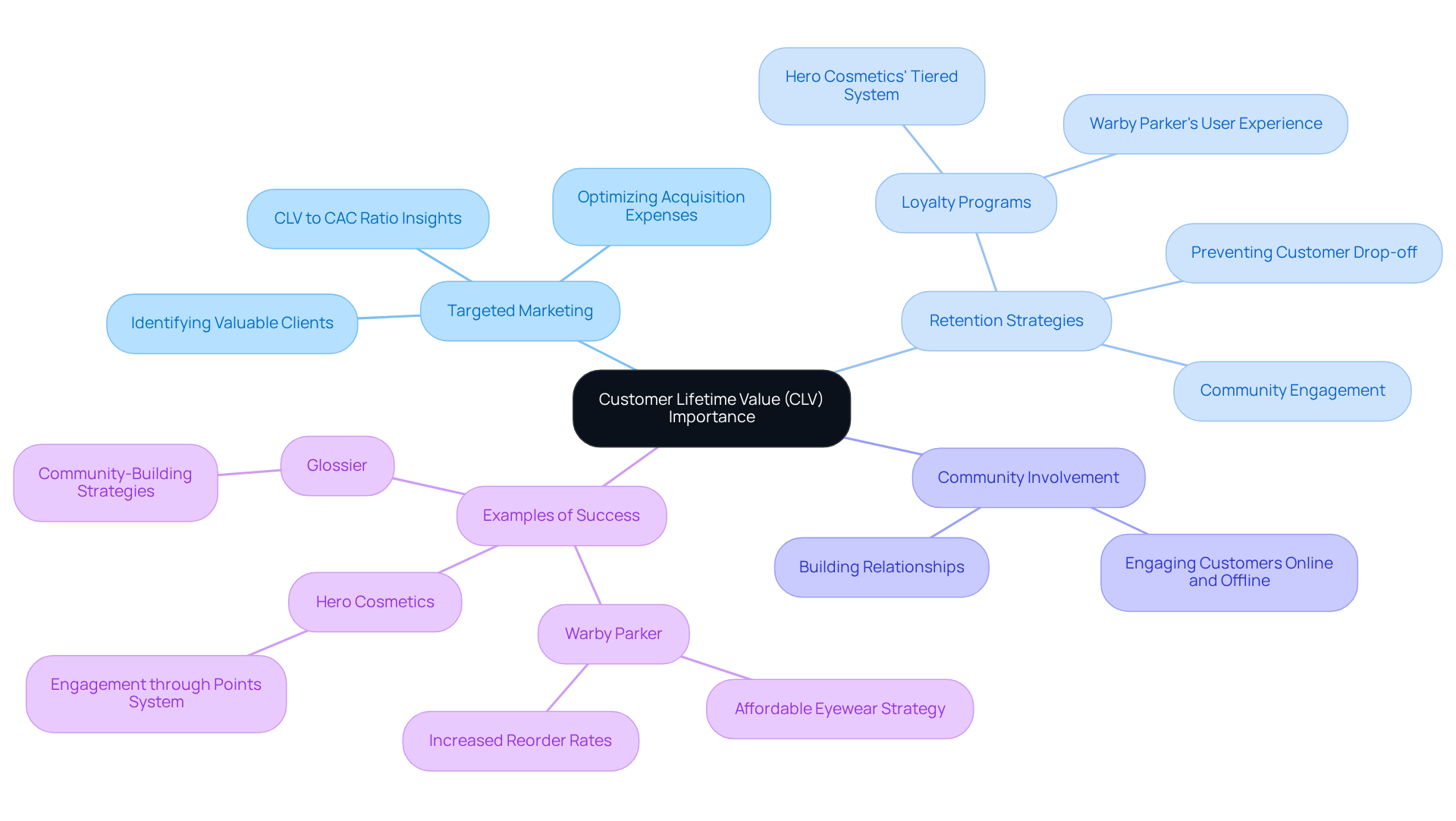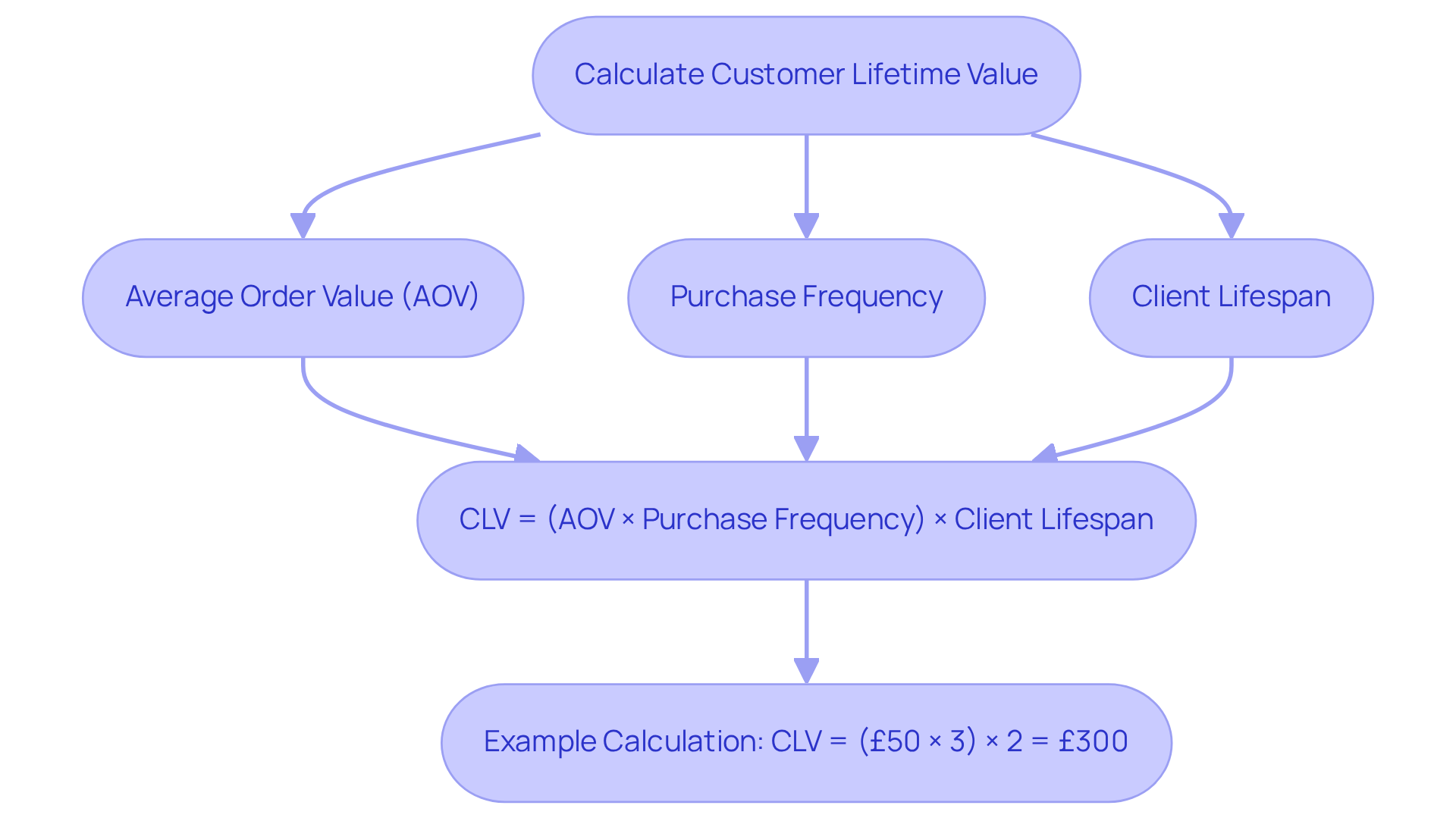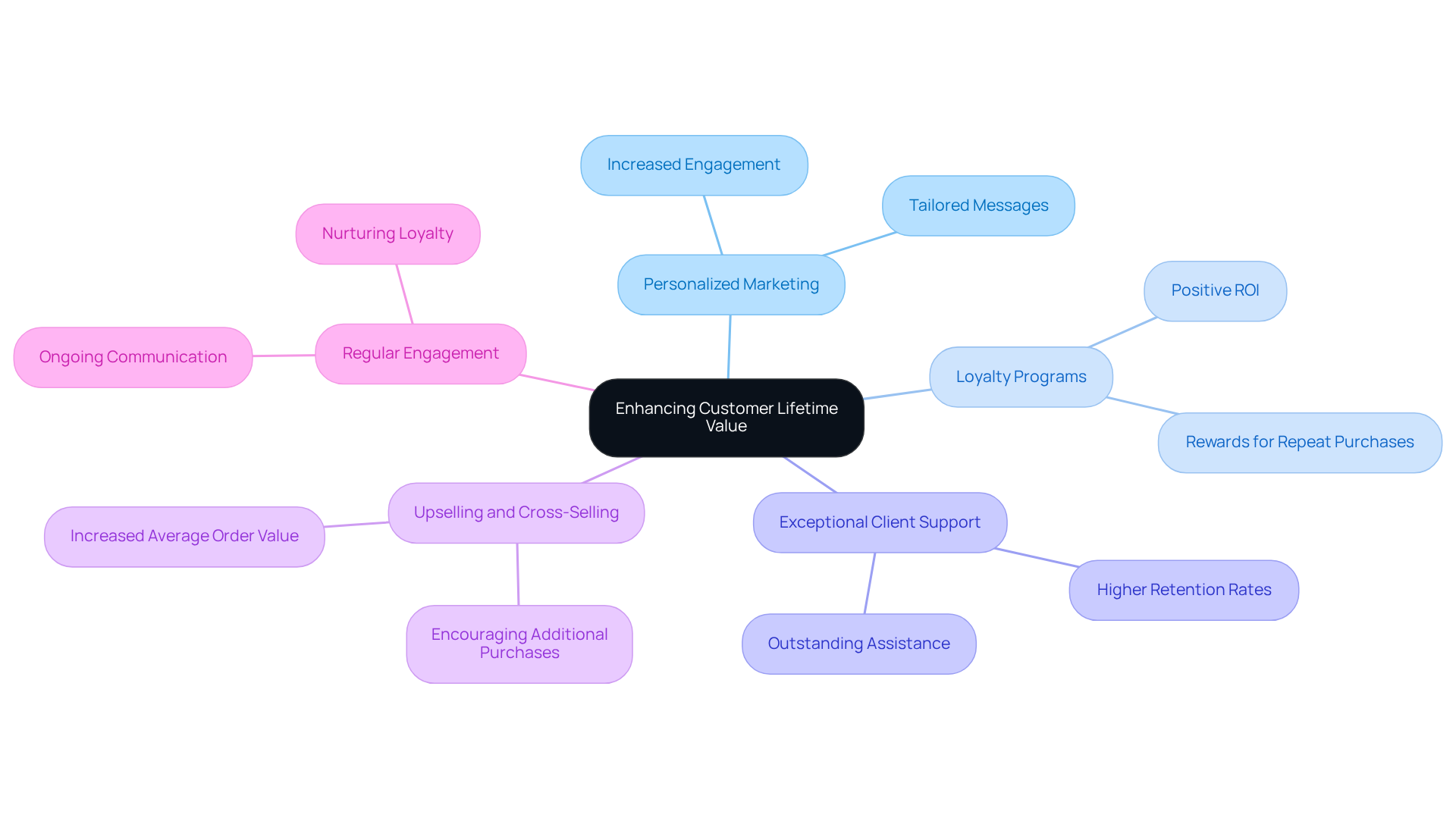
Overview
Customer lifetime value (CLV) stands as a pivotal metric for direct-to-consumer (DTC) brands, quantifying the total revenue anticipated from a customer throughout their relationship with the brand. This metric not only guides marketing strategies but also informs resource allocation. By grasping the significance of CLV, DTC companies can strategically concentrate on high-value clients, optimize acquisition costs, and refine retention strategies. Such focus ultimately propels sustainable growth and profitability in an increasingly competitive market.
Introduction
Understanding customer lifetime value (CLV) is essential for direct-to-consumer (DTC) brands navigating an intensely competitive landscape. This crucial metric quantifies the revenue potential from individual customers and informs strategic decisions that can significantly influence profitability and growth. As customer acquisition costs continue to escalate, many brands find themselves challenged in effectively leveraging CLV insights. Therefore, how can DTC companies harness this powerful metric to enhance customer relationships and drive sustainable success?
Define Customer Lifetime Value (CLV)
Customer lifetime value (CLV) is an essential metric that quantifies the total revenue a business can anticipate from an individual throughout their entire relationship with the brand. This metric encompasses all purchases made by the client, adjusted for the costs associated with acquiring and serving them.
Understanding is crucial for firms as it guides their long-term strategies related to client relationships, marketing expenditures, and retention initiatives. For instance, in e-commerce, companies often find that a well-calculated customer lifetime value can aid in customizing their marketing strategies to enhance client engagement and loyalty.
In 2025, the average customer lifetime value varies across industries, reflecting diverse consumer behaviors and purchasing patterns, underscoring the importance of segmenting clients based on their lifetime value. Companies can analyze their clientele to identify high-value groups, allowing for efficient resource allocation and improved marketing initiatives.
As noted by David Reibstein, a professor of marketing, the likelihood of selling to a current client is up to 14 times greater than selling to a new client, emphasizing the significance of nurturing existing relationships. Furthermore, adopting an omnichannel model can improve the LTV:CAC ratio, demonstrating how businesses can leverage customer lifetime value insights for enhanced marketing strategies.
Ultimately, utilizing customer lifetime value insights empowers companies to focus on high-value individuals, refining their strategies for sustained growth and profitability.

Explain the Importance of CLV for DTC Brands
For direct-to-consumer (DTC) companies, customer lifetime value is a pivotal metric that profoundly influences various facets of business planning. It empowers companies to pinpoint their most valuable clients, thereby enabling targeted marketing efforts that significantly enhance return on investment. By harnessing insights derived from customer lifetime value, companies can optimize their acquisition expenses and concentrate on retention strategies that foster loyalty. A heightened customer lifetime value not only indicates a propensity for repeat purchases but also plays an indispensable role in sustaining revenue growth amidst intense competition. This metric serves as a guiding compass for DTC companies, steering them to align marketing expenditures with anticipated customer lifetime value, ultimately safeguarding long-term profitability.
As DTC companies grapple with escalating customer acquisition costs (CAC), understanding and leveraging customer lifetime value becomes imperative for formulating effective marketing strategies. Numerous successful examples abound, such as Warby Parker, which bolstered its CLV by offering affordable eyewear alongside an exceptional user experience, resulting in increased reorder rates. Warby Parker's approach exemplifies how a focus on can directly influence customer lifetime value and the efficacy of marketing. Similarly, companies like Hero Cosmetics have instituted tiered loyalty programs that acknowledge consumer engagement, further amplifying their customer lifetime value. These strategies not only attract new clients but also nurture existing relationships, thereby promoting sustainable growth.
Moreover, community involvement has emerged as a significant trend in enhancing customer lifetime value, as companies that cultivate robust relationships with their clients can bolster loyalty and retention. The integration of online and offline experiences is also crucial, as it enables DTC companies to engage with clients in their preferred environments, thereby enriching their overall shopping experience. By comprehending and leveraging customer lifetime value, DTC companies can adeptly navigate the challenges posed by rising CAC and devise marketing strategies that ensure enduring success.

Outline How to Calculate Customer Lifetime Value
Calculating customer lifetime value is a critical process that demands a systematic approach, encapsulated by the formula: customer lifetime value = (Average Order Value × Purchase Frequency) × Customer Lifespan. Let’s delve into the essential components:
- Average Order Value (AOV): This represents the average amount an individual spends per transaction. For many Direct-to-Consumer (DTC) brands, the AOV hovers around £50, establishing a common baseline for revenue calculations.
- Purchase Frequency: This metric indicates how often an individual makes a purchase within a specified timeframe, such as annually. For instance, if a client makes three purchases each year, understanding this frequency is vital for grasping revenue generation.
- Client Lifespan: This measures the average duration an individual remains engaged with the company. An average client lifespan may approximate two years, though this can vary based on the manufacturer and product category.
By multiplying these three components, businesses can derive a comprehensive customer lifetime value figure that accurately reflects the anticipated revenue from a client over their lifetime. For example, if a company has an AOV of £50, a purchase frequency of three times per year, and a lifespan of two years, the CLV calculation would be: CLV = (£50 × 3) × 2 = £300.
Enhancing this calculation with historical data or predictive analytics can significantly improve precision, empowering brands to make informed decisions regarding marketing strategies and client engagement initiatives. Understanding customer lifetime value is essential for optimizing (CAC) and ensuring sustainable growth. A healthy LTV:CAC ratio is typically seen as 3:1, indicating effective client acquisition methods. Furthermore, statistics reveal that 93% of clients are likely to make repeat purchases from businesses that deliver exceptional service, emphasizing how retention strategies are crucial in maximizing customer lifetime value.

Discuss Strategies to Enhance Customer Lifetime Value
Enhancing customer lifetime value requires a multifaceted approach. To effectively capture attention and build interest, consider the following strategies:
- Personalized Marketing: Tailor your marketing messages and offers based on client preferences and behaviors. This targeted approach significantly increases engagement and conversion rates.
- Loyalty Programs: Establish loyalty initiatives that reward repeat purchases. Such programs motivate patrons to return and spend more over time, fostering long-term relationships.
- Exceptional Client Support: Deliver outstanding assistance to create positive experiences. This commitment to service leads to higher retention rates and customer satisfaction.
- : Encourage clients to purchase additional products or enhance their existing purchases. This strategy effectively increases the average order value and maximizes revenue potential.
- Regular Engagement: Maintain ongoing communication with customers through newsletters, social media, and personalized follow-ups. This consistent interaction keeps your brand top-of-mind and nurtures customer loyalty.
By focusing on these strategies, direct-to-consumer (DTC) brands can significantly boost their customer lifetime value. This enhancement not only leads to increased profitability but also fosters sustainable growth in a competitive market.

Conclusion
Understanding customer lifetime value (CLV) is essential for direct-to-consumer (DTC) brands that seek to maximize profitability and cultivate enduring relationships with their clients. This critical metric not only sheds light on the revenue potential from each customer but also guides strategic decisions regarding marketing, customer acquisition, and retention efforts. By effectively leveraging CLV, DTC brands can customize their strategies to boost customer engagement and loyalty, ultimately fostering sustained business growth.
Throughout the article, we explored key insights, including:
- The necessity of accurately calculating CLV to inform marketing expenditures
- The importance of nurturing existing customer relationships
- Various strategies that can enhance CLV
Personalized marketing, loyalty programs, exceptional customer support, and ongoing engagement emerged as effective tactics for increasing customer retention and maximizing revenue. Furthermore, the examples of successful brands underscored the tangible benefits of a strong focus on customer lifetime value.
In a competitive landscape where customer acquisition costs continue to escalate, understanding and improving customer lifetime value is more critical than ever. DTC brands are urged to adopt a holistic approach that prioritizes customer satisfaction and engagement, ensuring they not only attract new clients but also nurture lasting relationships with existing ones. By doing so, these brands can navigate challenges effectively and position themselves for long-term success in the market.
Frequently Asked Questions
What is Customer Lifetime Value (CLV)?
Customer lifetime value (CLV) is a metric that quantifies the total revenue a business can expect from an individual customer throughout their entire relationship with the brand, factoring in all purchases and the costs associated with acquiring and serving that customer.
Why is understanding CLV important for businesses?
Understanding CLV is crucial as it guides long-term strategies related to client relationships, marketing expenditures, and retention initiatives, helping businesses tailor their marketing strategies to enhance client engagement and loyalty.
How does CLV vary across industries?
The average customer lifetime value varies across industries, reflecting different consumer behaviors and purchasing patterns, highlighting the importance of segmenting clients based on their lifetime value.
What advantages does analyzing customer lifetime value offer?
Analyzing customer lifetime value allows companies to identify high-value customer groups, enabling efficient resource allocation and improved marketing initiatives.
How does selling to existing clients compare to selling to new clients?
The likelihood of selling to a current client is up to 14 times greater than selling to a new client, which underscores the importance of nurturing existing customer relationships.
What is the significance of adopting an omnichannel model in relation to CLV?
Adopting an omnichannel model can improve the LTV:CAC (Customer Lifetime Value to Customer Acquisition Cost) ratio, allowing businesses to leverage CLV insights for enhanced marketing strategies.
How can companies use CLV insights for growth and profitability?
By utilizing CLV insights, companies can focus on high-value individuals and refine their strategies to drive sustained growth and profitability.
FAQs











